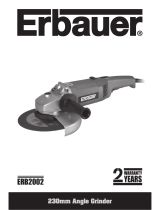
Page
CONTENTS
1. PRODUCT NAME ............................................................................................................................. 1
2. MARKETING OBJECTIVE ............................................................................................................... 1
3. APPLICATIONS ................................................................................................................................ 1
4. SELLING POINTS ............................................................................................................................ 2
4-1. Vibration-absorbing Main Handle and Side Handle ...........................................................................2
4-2. Prolonged Service Life of the Carbon Brushes thanks to the New Construction ...............................3
4-3. Low Gear Sound (Roughness) ..........................................................................................................3
4-4. Class-top Overload Durability ............................................................................................................4
4-5. Soft Grip Handle ................................................................................................................................5
4-6. Dust-proof Ball Bearing Thanks to the Labyrinth Construction ..........................................................5
4-7. Wheel Guard Angle-Adjustable without Using a Tool ........................................................................ 5
5. SPECIFICATIONS ............................................................................................................................ 6
6. COMPARISONS WITH SIMILAR PRODUCTS ................................................................................ 8
6-1. Specification Comparisons ................................................................................................................8
6-2. Practical Test Data ...........................................................................................................................10
7. PRECAUTIONS IN SALES PROMOTION ...................................................................................... 11
7-1. Handling Instructions ....................................................................................................................... 11
7-2. Caution on Name Plate .................................................................................................................... 11
7-3. Precautions on Usage .....................................................................................................................12
7-4. Measures taken when the wheel nut cannot be removed ...............................................................12
8. PRECAUTIONS IN DISASSEMBLY AND REASSEMBLY ............................................................ 13
8-1. Disassembly ....................................................................................................................................13
8-2. Reassembly .....................................................................................................................................15
8-3. Lubrication Points and Types of Lubricant .......................................................................................17
8-4. Tightening Torque ............................................................................................................................17
8-5. Wiring Diagram ................................................................................................................................18
8-6. Insulation Tests ................................................................................................................................18
8-7. No-load Current Value .....................................................................................................................18
9. STANDARD REPAIR TIME (UNIT) SCHEDULES ......................................................................... 19
Assembly Diagram for G 18SCY
Assembly Diagram for G 18UAY
Assembly Diagram for G 18SEY
Assembly Diagram for G 18UBY
Assembly Diagram for G 23SCY
Assembly Diagram for G 23UAY
Assembly Diagram for G 23SEY
Assembly Diagram for G 23UBY






















